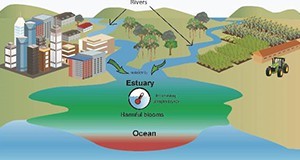Abstract
Climate change is expected to result in increased temperatures of nearshore ocean water, and this could lead to increased growth of harmful microorganisms. These include algae that form noxious or toxic blooms, including red tides, and bacteria and other pathogens. This situation could have negative consequences in regard to human health and also Florida’s ocean-related economy. This 6-page fact sheet discusses projected ocean temperatures, how harmful microorganisms living in the ocean might respond, and how this might affect people, and identifies actions that could be taken to reduce these impacts. Written by Karl Havens, and published by Florida Sea Grant, June 2015.
References
Burge, C.A., C.M. Eakin, C.S. Friedman, B. Froelich, P.K. Hershberger, E.E. Hofmann, L.E. Petes, K.C. Prager, E. Weil, B.L. Willis, S.E. Ford, and C.D. Harvell. 2014. "Climate change influences on marine infectious diseases: implications for management and society." Annual Review of Marine Science 6: 249-277. https://doi.org/10.1146/annurev-marine-010213-135029
Doney, S.C., M. Ruckelshaus, J.E. Duffy, J.P. Barry, F. Chan, C.A. English, H.M. Galindo, J.M. Grebmeier, A.B. Hollowed, N. Knowlton, J. Polovina, N.N. Rabalais, W.J. Sydeman, and L.D. Talley. 2012. "Climate change impacts on marine ecosystems." Annual Review of Marine Science 4: 11-37. https://doi.org/10.1146/annurev-marine-041911-111611
Fleming, L.E., B. Kirkpatrick, L.C. Backer, C.J. Walsh, K. Nierenberg, J. Clark, A. Reich, J. Hollenbeck, J. Bensen, Y.S. Cheng, J. Naar, R. Pierce, A.J. Bourdelais, W.M. Abraham, G. Kirkpatrick, J. Zaias, A. Wanner, E. Mendes, S. Shalat, P. Hoagland, W. Stephan, J. Bean, S. Watkins, T. Clarke, M. Byrne, and D.G. Baden. 2011. "Review of Florida red tide and human health effects." Harmful Algae 10: 224-233. https://doi.org/10.1016/j.hal.2010.08.006
Hallegraeff, G.M. 2010. "Ocean climate change, phytoplankton community responses, and harmful algal blooms: a formidable predictive challenge." Journal of Phycology 46: 220-235. https://doi.org/10.1111/j.1529-8817.2010.00815.x
Havens, K.E. 2007. "Cyanobacteria blooms: effects on aquatic ecosystems." Advances in Experimental Medicine and Biology 619: 745-759.
IPCC. 2014. Climate Change 2014: Synthesis Report. Contribution of Working Groups I, II and III to the Fifth Assessment Report of the Intergovernmental Panel on Climate Change. Core Writing Team, R.K. Pachauri and L.A. Meyer (eds.), IPCC, Geneva, Switzerland, 151 pp.
Moss, B., S. Kosten, Mariana Meerhoff, R.W. Batterbee, E. Jeppesen, N. Mazzeo, K. Havens, G. Lacerot, Z. Liu, L. D Meester, H. Paerl, and M. Scheffer. 2011. "Allied attack: climate change and eutrophication." Inland Waters 1: 101-105. https://doi.org/10.5268/IW-1.2.359
Paerl, H.W., and J. Huisman. 2008. "Blooms like it hot." Science 320: 57-58. https://doi.org/10.1126/science.1155398

